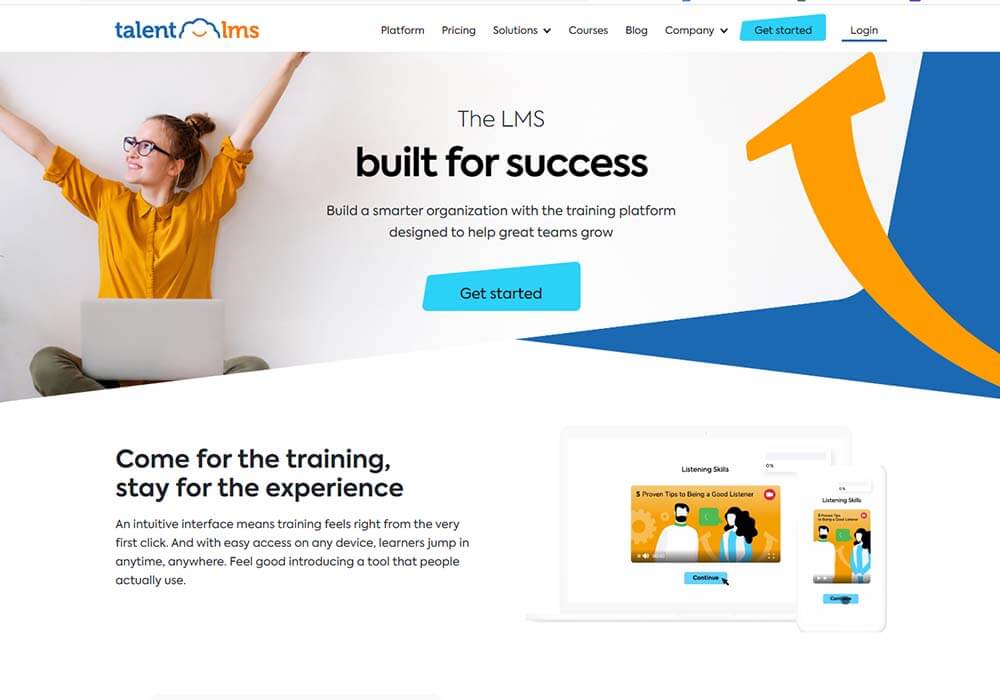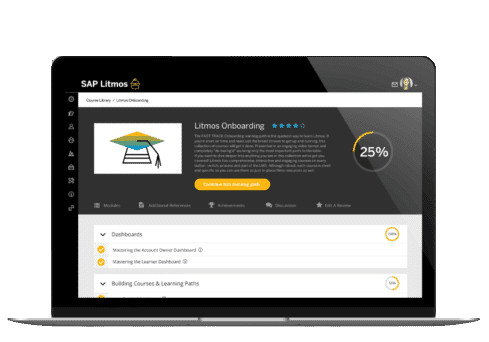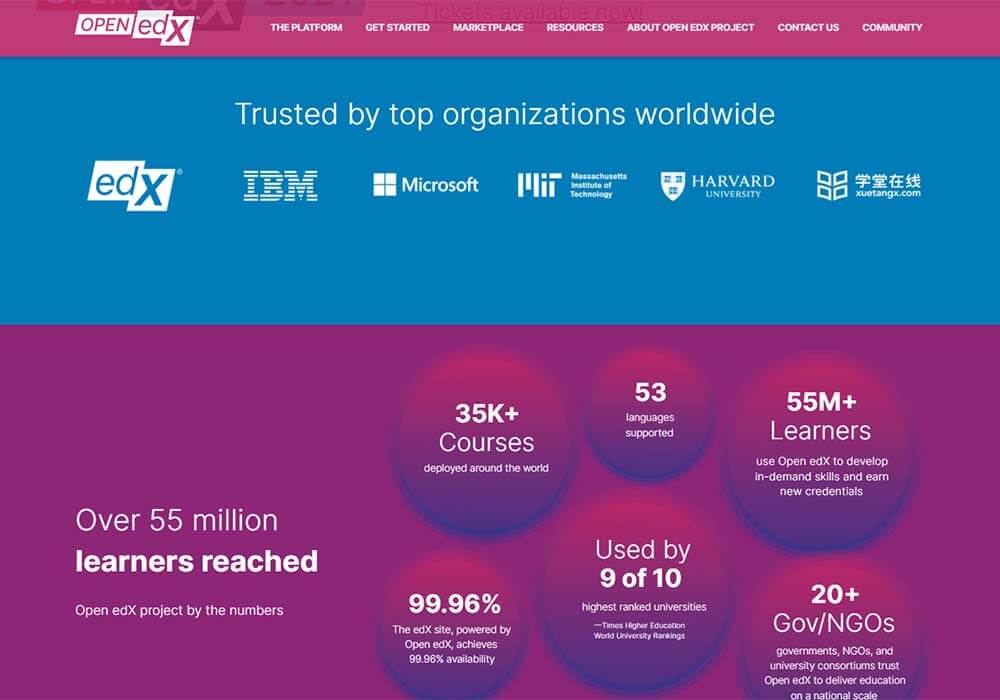Companies and institutions have always had to systematize the training and education of staff, students, clients, and users and have used various registers, ledgers, and filing systems for this purpose. But in today’s digital economy, with workers and students dispersed across the globe, a greater need to keep learning up-to-date, and, perhaps most importantly, moving learning itself to digital and online media, we are currently facing a very different situation.
Enter the learning management system (LMS) – a necessity today for most businesses and educational institutions. In fact, it goes even further than that – the learning management system (LMS) is the backbone of the e-learning industry.
An LMS allows users to monitor and track learners’ progress in courses and training programs, assess performance, and provide an interactive environment for learners. It provides the platform and technology for universities to teach students worldwide, companies to train remote employees, and entrepreneurs to market their knowledge to a wide audience. In fact, even the major MOOC platforms, such as Coursera, edX, Udacity, and Skillshare, can all be considered LMS – but in this article, we’ll focus on the variety of LMS that you can implement in your own organization.
For those who are considering adding an LMS to their business or educational institution, there are plenty of excellent options available. In this article, I’ll be showcasing some of the most noteworthy examples of LMS out there.
These are nine examples of learning management systems (LMS) suitable for businesses, non-profits, and educational institutions.
LMS Examples
Example #1: iSpring Learn

A modern and sleek example of a learning management system is iSpring Learn. Perfect for businesses who want to deliver a smooth and intuitive learning experience for their employees or customers, this LMS is known for its user-friendliness and ease of use.
Some of iSpring Learn’s key benefits include:
- Advanced reporting. This LMS allows you to generate detailed reports on learner progress, identify gaps in their knowledge, and evaluate the overall effectiveness of your training programs.
- Flexible deployment options. iSpring Learn can be deployed under your own domain name, it integrates with the REST / SOAP API, and it’s even available as a mobile app.
- Fully customizable. This LMS can be adapted to your specific needs and requirements with custom branding, localization, and white labeling for both the desktop and mobile versions.
- Gamification. Gamification is here to stay, and iSpring Learn provides all the tools you need to make learning more enjoyable with features such as learner leaderboards, points, and badges.
- Learning tracks. With iSpring Learn, you can combine individual lessons to create a learning track with a pre-determined completion order and custom assignments.
All in all, iSpring Learn is a great choice for businesses that are looking for a user-friendly and feature-rich LMS. While it’s not free, you do have the option to give it a try with their 30-day free trial. Or, if you’d like to learn more about iSpring, make sure to read our full review of the iSpring Suite, which is a powerful learning content authoring toolkit that integrates seamlessly with iSpring Learn.
Example #2: TalentLMS

A great LMS available and ready to use right “out of the box” is TalentLMS. TalentLMS is one of the most user-friendly options for employee training. This is our main recommendation for smaller businesses looking to get started with an LMS.
TalentLMS is a great system for organizing and distributing company-specific training content. It helps automate time-consuming and troublesome tasks and saves both time and money if used to its full potential.
The LMS scales well to larger organizations, but the greatest strengths of this option are its ease of implementation and its straightforward and relatively low pricing. And with an unlimited free trial that you can use for up to 10 courses and 5 users, you have the opportunity to properly test out the platform before making a decision.
Like most modern LMS, TalentLMS is cloud-based, meaning that you will not have to worry about local hosting headaches and server maintenance. TalentLMS is the learning management system of choice for companies such as Deliveroo, Isuzu, and Rosetta Stone.
Example #3: Moodle

One of the oldest and most popular open-source LMS in the world is Moodle. In Europe, Moodle recently had a staggering 65% market share, and while it’s not as popular in the United States, it continues to be one of the most influential LMS worldwide.
Open-source and free, Moodle is distributed under the GNU General Public License, and it’s the LMS of choice for most European universities. Moodle focuses on the social aspect of learning, helping students interact with each other and their instructors, similar to social networking sites. If your training program involves a lot of collaboration, Moodle will serve you well.
But, open-source LMS is not for everyone. Configuring an open-source LMS such as Moodle to your needs can be a difficult task unless you have a dedicated team for it. Open-source LMS often performs the best within companies and organizations that:
- Have a team that is ready and able to do the heavy lifting in programming and development.
- Are looking for something that comes with a lower (to zero) price tag.
- Need to have complete control over data ownership and security.
Moodle is an excellent LMS, but if you’re looking for something ready out of the box, a commercial SaaS LMS could be a better option.
Example #4: Litmos

Litmos is a good example of a robust enterprise-grade SaaS LMS. It provides an all-in-one learning platform, and many of the world’s leading companies rely on Litmos to power their training programs, from onboarding new employees to developing skills in the workforce. Examples of companies that use Litmos include Hewlett-Packard and Ford.
With over 100 integrations and more than 10 million users worldwide, it has a huge user base. Litmos includes features like extensive gamification for increased learner engagement, customized learning paths for trainees, and social collaboration.
While it’s a robust and well-respected platform, it is not necessarily suitable for smaller companies (or educational institutions). Pricing is not transparent, and you will need to contact them for a quote. Note that you can, however, check out the platform with a free trial.
Example #5: Canvas LMS

Canvas has been one of the most popular LMS in the United States for several years – and it’s the LMS of choice for some of the world’s top universities, such as Stanford University and Cornell University. Open-source by design, Canvas was launched in 2011 by two BYU graduates Brian Whitmer and Devlin Daley, and its popularity has shot up like a rocket since that time.
Designed to compete with Blackboard LMS, developers of the Canvas LMS emphasized its simplicity, ease of use, and modern toolset. At a time when an LMS was seen as something usable only by tech-savvy people, the Canvas LMS came and proved that an LMS could be intuitive enough to be used by anyone.
Another key reason why the popularity of Canvas grew so quickly is that it had cloud-based hosting from the beginning. This was during a time when cloud-based computing was still a novel concept to most. Keep in mind that Blackboard, their biggest competitor, did not make the switch to a fully functional cloud-based infrastructure until as late as 2018.
Example #6: Blackboard Learn

Blackboard Learn was the most popular learning management system for more than 20 years before being dethroned by Canvas LMS in 2018. Blackboard is the LMS most educators are familiar with and it has helped universities like CUNY, the University of Texas at Austin, and Penn State to transform their teaching practices with digital tools for the first time.
With over 100 million active users, Blackboard Learn has been used in more than 3 million courses at colleges and universities around the world since its inception in 1999. It’s also been recognized with awards like “Best Educational Product” from PC Magazine and “Most Innovative Company” from Red Herring magazine.
However, while Blackboard was indeed once a great innovator, it’s arguable whether that title still applies today. Unlike Canvas LMS, Blackboard was very slow to embrace cloud-based hosting, and despite an impressive amount of features, Blackboard continues to lose LMS market share as of the writing of this article. Only time will tell whether this trend will continue.
Example #7: MOOC Platforms

MOOC platforms are unique examples of an LMS because they not only organize learners in their platforms but are also educators in their own right. Companies like Coursera, FutureLearn, Udemy, and edX are bridging the gap between higher education institutions, corporate learning environments, and people looking to learn.
Course information is developed and hosted within their platform. Some of them, most notably Coursera and edX, also partner with universities to give students access to certificate and degree programs.
Instead of a single institution or company responsible for creating the course content, providing feedback for students, and creating learners’ communities, these platforms act as both aggregators (and often course creators themselves). They provide an option for universities and companies alike to outsource part (or all) of their LMS needs to these MOOCs. Instead of developing standard online training, they can send their students or employees to places like Coursera to take existing anti-harassment training.
Some of the platforms have also launched enterprise versions that allow companies to host their own internal courses for their employees alongside the public offerings. This is an interesting fusion of the two different, established examples of the LMS.
Example #8: Google Classroom

Google Classroom is a very popular learning management system in K-12 schools. It’s especially prevalent in smaller-sized K-12 schools (in districts with less than 2,500 students), where it holds a 24.6% market share.
But why is Google Classroom so widely used?
- One of the easiest learning management systems to create, distribute, and grade assignments.
- Fully free to use.
- Integrates with Google Drive so you can find all of your work in one place.
- Teachers can easily share files between themselves and students without having to send emails back and forth.
All in all, Google Classroom has many advantages going for it. It may not be as feature-rich or robust as some of the other options on the list, but for most people who just need an LMS without all of the bells and whistles and who do not mind using the Google ecosystem of products, Google Classroom is a solid LMS choice.
Example #9: Open edX

Another good example of LMS is OpenEdX. This open-source LMS comes from edX — a free Massive Open Online Course (MOOC) provider co-founded by Harvard and MIT in 2012. Initially envisioned for delivering MOOCs to online students, OpenEdX is quickly becoming a popular system for higher education, enterprise, and government organizations alike.
Many companies, such as McKinsey & Co, Johnson & Johnson, and Microsoft, use Open edX to create their online training courses. It’s a reliable platform that can be scaled to any size, developed for mobile learning, and has modern capabilities such as AR and VR. Open edX has also been translated into more than 30 languages and can be deployed on any server with a LAMP stack.
With an easy-to-use interface for instructors and learners alike, Open edX provides a powerful tool for educators of all levels to create online courses in minutes without having to worry about hosting or scaling their content. While its popularity is not on the level of Canvas or Blackboard, Open edX still has its place in the LMS market, especially among larger organizations.



